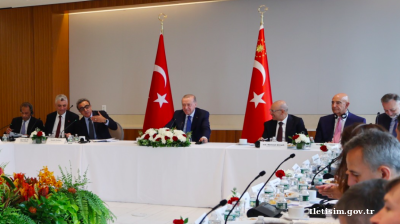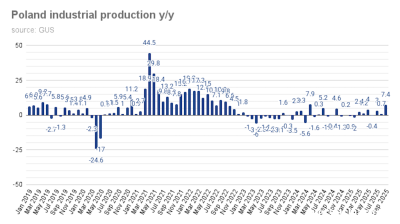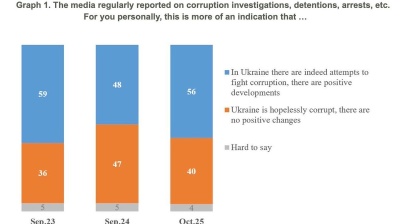Russia’s manufacturing PMI surged in February to post 54.7, up from 52.4 in January, putting in its biggest gains in 13 years, S&P Global reported on March 1. (chart)
Any result above the 50 no-change mark represents an expansion in manufacturing. February’s result was the biggest gain since 2017.
“Russian manufacturers recorded a strong upturn in operating conditions during February,” S&P Global said in a note. “Sharper expansions in new orders and output spurred a renewed rise in employment and a further uptick in input buying. The rate of new sales growth was the steepest since March 2011 despite a faster fall in new export orders dragging on the overall upturn. Business confidence ticked higher, as future output expectations improved to the strongest since July 2023.” The strong result was mirrored in a pick-up in Russia’s industry production which rose from a lacklustre 2.7% y/y growth in December to 4.6% in January y/y, Rosstat reported on February 29.
The Russian economy is experiencing an increase in the number of new orders, which are expanding at their fastest pace since March 2011. The increase in sales was associated with increased customer demand and the introduction of new products. Overall production growth was the strongest since March 2019.
However, S&P Global notes that there are still problems with supply chains.
“Supply chain challenges remained widespread, however, hampering firms' ability to replenish stocks and pushing input prices up at a quicker pace. Moreover, price competition to drive new sales led to the slowest increase in selling prices for eight months,” S&P Global said.
Most of the growth is being driven by domestic demand as export orders fell for their fourth consecutive month and the fall was the steepest in over a year, S&P Global said.
Strong sales and high demand has led companies to hire new staff in the context of an already very tight labour market, due to drain on the labour pool from the war. Staffing numbers have now risen in 15 of the last 16 months, with the pace of job creation solid overall.
“Greater hiring activity helped relieve pressure on capacity during February, as backlogs of work at goods producers contracted at a strong rate. The pace of contraction was quicker than the series average," S&P Global said.
Inflation remains a problem, but following a hike in the Central Bank of Russia (CBR)’s overnight rate to 16% in December, the inflationary pressure seems to be abating on the back of falling inflationary expectations by the public. Inflation held more or less steady in February at 7.6%, according to the latest data from Rosstat.
“Manufacturers registered a marked increase in cost burdens that was broadly in line with the long-run series average. Higher transportation, supplier and raw material costs reportedly drove inflation," S&P Global said. “Although input costs increased at a quicker pace, manufacturers raised their selling prices at a softer rate. February data indicated the slowest uptick in output charges since June 2023."
S&P Global’s goods producer panellists noted shortages of raw materials during February, as supplier performance deteriorated further. Delivery times worsened solidly, as logistics issues led to extended delays. Difficulties sourcing some items led to challenges replenishing stocks of purchases and saw finished goods used to supplement production. Moreover, current holdings of inputs and semi-finished items fell at the fastest pace since last October, S&P Global reports.
“Finally, manufacturing firms were optimistic in the year ahead outlook for output in February. The level of positive sentiment was historically elevated amid planned investment in new machinery and hopes of further expansions in new orders. Moreover, the degree of confidence was the most marked in seven months," S&P Global concluded.
Data

Chobani yoghurt king Hamdi Ulukaya becomes richest Turk
Knocks Murat Ulker into second place in Forbes ranking as his company's valuation leaps to $20bn.

Poland’s industrial production jumps 7.4% y/y in September
September saw an unexpectedly sharp increase in industrial production after the surprise gain of 0.7% y/y in August.
Ukrainian M&A market grows 22% despite war, driven by local investors
Two large acquisitions by agriculture holding MHP and mobile operator Kyivstar accounted for more than half of the total deal value.

Ukraine’s credibility crisis: corruption perception still haunts economic recovery
Despite an active reform narrative and growing international engagement, corruption remains the biggest drag on Ukraine’s economic credibility, according to a survey by the Kyiv International Institute of Sociology.




_2_1761012864.jpg)